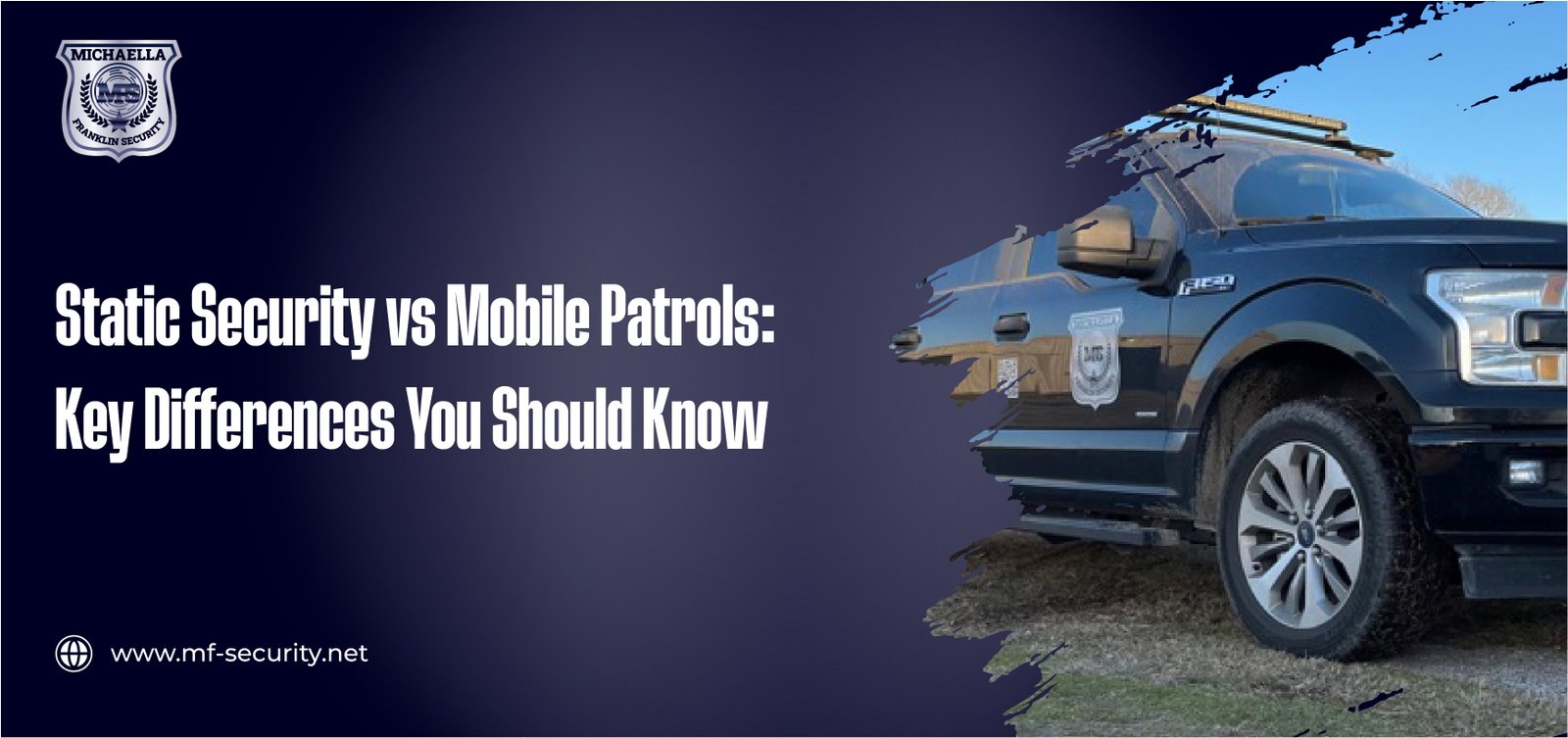Introduction
Security is no longer a luxury—it’s a necessity. Whether you’re running a retail store, managing an office building, overseeing a construction site, or responsible for a residential community, protecting people and property is one of your top priorities. The challenge is figuring out the best way to do that. Two of the most common approaches are static security and mobile patrols.
At first glance, these options may sound similar. After all, both involve trained security personnel tasked with preventing theft, deterring vandalism, and responding to emergencies. But the way each service works, the situations where they excel, and even their costs can be very different. Choosing between static security and mobile patrols isn’t just a matter of budget—it’s about aligning protection with your specific needs.
This guide breaks down the key differences between static security and mobile patrols, highlights their benefits and drawbacks, and shows how businesses and communities can decide which service is right for them—or even whether a hybrid approach is the best solution.
What Is Static Security?
Static security refers to guards who remain stationed in one location. They might be positioned at a building entrance, a reception desk, or near a sensitive area such as a server room or warehouse. Unlike mobile patrols, static guards do not move from site to site; their role is to provide a constant, visible presence in one designated space.
Keep your site safe around the clock—request a custom patrol and static guard plan today.
Typical Responsibilities of Static Guards
- Access Control: Checking IDs, monitoring entry points, logging visitors.
- Surveillance: Watching CCTV monitors, conducting routine checks of the same area.
- Emergency Response: Acting immediately in case of fire alarms, break-ins, or disturbances.
- Customer Interaction: Greeting visitors, assisting staff or clients, providing directions.
- Deterrence: Reducing risk by being a visible authority figure.
Benefits of Static Security
- Always On-Site: Guards can respond instantly to incidents.
- Personalized Knowledge: They become familiar with the property and staff, spotting unusual behavior more quickly.
- High Deterrent Value: Criminals are less likely to attempt theft when they see a permanent guard.
Limitations of Static Security
- Cost: Because guards are on-site full time, services are more expensive.
- Limited Coverage: Guards are confined to a specific location rather than covering multiple properties.
Static security is often considered the “gold standard” for high-value sites where continuous monitoring is non-negotiable.
What Are Mobile Patrols?
Mobile patrols take a different approach. Instead of staying in one place, guards move between multiple sites, either on a fixed schedule or randomly. Patrols may be carried out in marked security vehicles, on bicycles, or on foot, depending on the property layout and service contract.
Typical Responsibilities of Mobile Patrol Officers
- Property Inspections: Checking doors, gates, windows, and perimeters.
- Randomized Deterrence: Varying routes and times so intruders can’t predict patrol schedules.
- Alarm Response: Being dispatched when alarms go off to investigate and secure the site.
- Reporting: Providing detailed reports and incident logs after each round.
- Emergency Support: Assisting with lockouts, escorting employees, or handling unexpected issues.
Benefits of Mobile Patrols
- Cost-Effective: More affordable than static security because guards divide time across locations.
- Flexible: Can adjust frequency of visits depending on risk level.
- Unpredictability: Randomized patrols make it difficult for criminals to anticipate security presence.
- Wide Coverage: Ideal for large areas like parking lots, warehouses, or gated communities.
Limitations of Mobile Patrols
- Delayed Response: Guards may not be present when an incident happens.
- Less Familiarity: Officers may rotate sites, meaning they don’t always know staff or routines.
Mobile patrols work best where a full-time presence isn’t required, but regular visibility and deterrence are still valuable.
Key Differences Between Static Security and Mobile Patrol
While both services aim to reduce risk, they do so in different ways.
| Aspect | Static Security | Mobile Patrols |
|---|---|---|
| Presence | Guards stay in one location full-time | Guards move between multiple sites |
| Coverage | Limited to one property or area | Can cover several locations |
| Cost | Higher due to continuous presence | Lower since guards divide time |
| Response | Immediate reaction to incidents | Possible delay if off-site |
| Deterrence | Strong, visible presence 24/7 | Strong through unpredictability |
| Best Use | High-risk, high-value assets | Larger, low-to-medium-risk areas |
This distinction makes it clear that the decision isn’t about which is “better,” but rather which fits the property’s needs.
Effectiveness in Different Scenarios
High-Risk Environments
If you manage a jewelry store, bank, or construction site, static security is almost always the smarter choice. In these settings, the risk of theft or vandalism is too high to rely on occasional visits. A permanent presence ensures someone can intervene instantly.
Large or Spread-Out Properties
For business parks, residential communities, or schools, mobile patrols often make more sense. Their ability to cover multiple access points or buildings keeps costs lower while still discouraging intruders.
Event Security
Events like concerts or festivals often combine both. Static guards manage entry points and crowd control, while mobile patrols handle parking lots and outer perimeters.
Hybrid Solutions
Many organizations now use a layered approach—for example, a warehouse may have one static guard inside for access control, while mobile patrols monitor surrounding lots. This combination provides strong deterrence and wider coverage.
Cost Considerations
Static Security Costs
Factors that affect pricing include:
- Number of guards required per shift
- Level of training and certifications
- Whether coverage is 24/7 or only during operating hours
- Site location (urban vs rural)
Because guards are always on-site, static security is often the more expensive option.
Mobile Patrol Costs
Pricing depends on:
- Number of visits per day or night
- Distance between properties
- Time spent on inspections
- Whether marked vehicles are used
Mobile patrols are generally more budget-friendly, making them a good fit for organizations that need coverage but cannot justify full-time presence.
How to Choose the Right Security Service
When deciding between static security and mobile patrols, consider:
- Size of Property: Large properties or multiple sites may require patrols.
- Risk Level: High-value or sensitive areas usually need static security.
- Budget: If cost is a concern, mobile patrols can provide affordable deterrence.
- Business Needs: If employees or visitors require direct interaction, static guards are preferable.
- Combination Approach: For many organizations, blending both services is the most effective solution.
FAQs
1. What is the difference between static security and mobile patrols?
Static guards remain fixed in one place, providing constant oversight. Mobile patrols move between sites, offering flexible coverage.
2. Is static security more effective than mobile patrols?
Static guards are more effective for high-risk sites due to their immediate response. Mobile patrols are better for cost-effective deterrence across larger spaces.
3. Are mobile patrols cheaper than hiring static security guards?
Yes. Mobile patrols are usually less expensive because guards do not remain on-site full-time.
4. Can I combine static security with mobile patrols for better protection?
Absolutely. Many organizations use both—static guards for entrances, patrols for perimeter areas.
5. Which type of security is best for residential communities and businesses?
Residential communities often use patrols, while businesses with sensitive assets rely on static guards.
6. How do mobile patrols deter crime?
Their unpredictability makes it difficult for intruders to anticipate when patrols will arrive.
7. What industries most commonly use static security?
Retail, banking, construction, and corporate offices rely heavily on static security.
Conclusion
The decision between static security and mobile patrols isn’t about one being superior to the other—it’s about which aligns with your property’s unique needs. Static security provides a constant, reassuring presence and immediate response, making it ideal for high-risk or high-value sites. Mobile patrols, meanwhile, deliver flexibility, affordability, and broad coverage, making them perfect for larger, lower-risk areas.
In many cases, the most effective solution is a hybrid model that combines both strategies. By evaluating your risk level, budget, and goals, you can build a security plan that not only deters crime but also ensures peace of mind for everyone on your property.
Want a deeper look at daily patrol responsibilities? Read Mobile Patrol Security Officer Duties & Responsibilities Explained.





